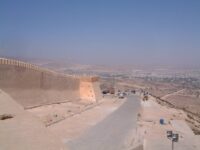Museum of Amazigh Heritage

This museum, opened in 2000, presents objects and collections of Moroccan heritage. First, a series of photos by Saïd Aoubraim, a native and teacher in Agadir, on the collective granaries. Then, in another room, we see a presentation of utensils used to extract argan oil and clay objects used for food preservation. A large exhibition is also devoted to the architecture of the oases of Salima Naji. Finally, the museum has a great collection of Berber jewelry. In addition, the museum is tastefully arranged, staged by Philippe Délis, a famous architect and scenographer who knew how to play with spaces and colors to make this place a modern space presenting ancient objects.
Several rooms are dedicated to various themes. First of all, a series of photos by Saïd Aoubraim, a native and teacher in Agadir, on the collective granaries. His different visions of southern Morocco (argan trees, sand dunes, landscapes, stone and adobe constructions) show us the richness of the regions through their diversity. A model of a collective granary of the high Atlas (walls in earth and stones, beams in poplars and ceiling in reed) allows us to understand even better the techniques of the past. In another room, it is up to us to safeguard this endangered rural heritage so that the memory of the men who gave it birth never dies.
Finally, the museum has a wonderful collection of Berber jewelry (collected mainly by Said Zitoun, a private collector): women’s ornaments, frontals, rings, fibulas, belts, anklets, earrings. The ornaments are presented with all the techniques of shaping, enameling and the tools that go with it. Several talismans that protect from bad oil, as well as a presentation of utensils used to extract argan oil and terracotta objects used to preserve food. A large exhibition is also devoted to the architecture of the oases of Salima Naji with the support of the BMCI, the Villa des Arts (see visit Casablanca) and the ONA Foundation Museum.
In addition to the reconstruction of an adobe wall at the entrance of the museum, we discover an art of building and an art of living. It is a journey into the collective memory of the craftsmen, a tribute to their work and their techniques of a past but glorious period. Moreover, the museum is tastefully arranged, staged by Philippe Délis, a famous architect and scenographer, who knew how to play with spaces and colors to make this place a modern space presenting ancient objects. We feel good, we move around freely and each theme is highlighted to give us the desire to know, to travel beyond the works proposed.
Video
How to get to the museum
The Amazigh museum : Avenue Hassan II – passage Aït Souss Agadir
Open from Monday to Saturday from 10 am to 7 pm (closed on holidays).
Visit with free guide. Entry 10 dirhams.
https://goo.gl/maps/8S4vhJHaaFBGzCd8A






